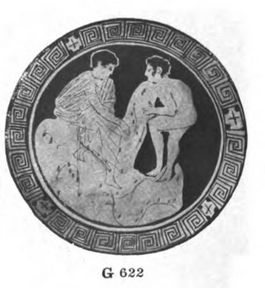Chapter 7: The Royal House of Athens
Previous Page Table of Contents Next Page
♠ E: Hik 5-7 – Euripides, Hiketides (Suppliants)
where my father reared me, Aethra, in a happy home, and gave me in marriage to Aegeus, Pandion’s son, according to the oracle of Loxias. Greek Text
♠ Hipp 887 – Euripides, Hippolitos
But, father Poseidon, with one of the three curses you once promised me kill my son Greek Text
♠ Hipp 1283 – Euripides, Hippolitos
Nobly-born son of Aegeus! Greek Text
♠ Hipp 1431 – Euripides, Hippolitos
But you, child of old Aegeus Greek Text
♠ Thes 3.3-4 – Plutarch, Theseus
Now Aegeus, king of Athens, desiring to have children, is said to have received from the Pythian priestess the celebrated oracle in which she bade him to have intercourse with no woman until he came to Athens. But Aegeus thought the words of the command somewhat obscure, and therefore turned aside to Troezen and communicated to Pittheus the words of the god, which ran as follows:—
Loose not the wine-skin’s jutting neck, great chief of the people,
Until thou shalt have come once more to the city of Athens.
[4] This dark saying Pittheus apparently understood, and persuaded him, or beguiled him, to have intercourse with his daughter Aethra. Aegeus did so, and then learning that it was the daughter of Pittheus with whom he had consorted, and suspecting that she was with child by him, he left a sword and a pair of sandals hidden under a great rock, which had a hollow in it just large enough to receive these objects. Greek Text
♠ Paus 2.33.1 – Pausanias, Description of Greece
The Troezenians possess islands, one of which is near the mainland, and it is possible to wade across the channel. This was formerly called Sphaeria, but its name was changed to Sacred Island for the following reason. In it is the tomb of Sphaerus, who, they say, was charioteer to Pelops. In obedience forsooth to a dream from Athena, Aethra crossed over into the island with libations for Sphaerus. After she had crossed, Poseidon is said to have had intercourse with her here. So for this reason Aethra set up here a temple of Athena Apaturia, and changed the name from Sphaeria to Sacred Island. She also established a custom for the Troezenian maidens of dedicating their girdles before wedlock to Athena Apaturia. Greek Text
♠ ApB 3.15.7 – Apollodoros, Bibliotheke (Library)
And journeying by way of Troezen, he lodged with Pittheus, son of Pelops, who, understanding the oracle, made him drunk and caused him to lie with his daughter Aethra. But in the same night Poseidon also had connexion with her. Now Aegeus charged Aethra that, if she gave birth to a male child, she should rear it, without telling whose it was; and he left a sword and sandals under a certain rock, saying that when the boy could roll away the rock and take them up, she was then to send him away with them. Greek Text
♠ Fab 37 – Hyginus, Fabulae
AETHRA: Neptune and Aegeus, son of Pandion, one night in the shrine of Minerva both lay with Aethra, daughter of Pittheus. Neptune conceded the child to Aegeus. Now he, on the point of returning to Athens from Troezene, put his sword under a stone, and told Aethra that when the boy could lift the stone and take his father’s sword, she should send him to him. He would recognize his son by that. And so later Aethra bore Theseus. When he had reached young manhood, his mother told him Aegeus’ instructions, showed him the stone so that he could get the sword, and bade him set out for Athens to Aegeus . . . and he killed all those who made the road unsafe. Latin Text
♠ Kallimachos, Hekale 235 – Callimachus 1, p. 231,ed. R. Pfeiffer. Oxford 1949
♠ Kallimachos, Hekale 236 – Callimachus 1, p. 232,ed. R. Pfeiffer. Oxford 1949
Paris, Louvre G622 (not G423, as Gantz): Attic red-figure cup with Theseus lifting the rock

E. Pottier, Vases antiques du Louvre, vol. 3 (1922), pl. 158
Beazley Archive Pottery Database
Stockholm, National Museum 1701: Attic red-figure lekythos with Theseus lifting the rock

Nationalmusei årsbok vol. 4 (1922), p. 129 fig. 43

Nationalmusei årsbok vol. 4 (1922), p. 130 fig. 44
Beazley Archive Pottery Database
♠ Bak 18.48 – Bakchylides, Odes
he has a sword slung over his bright shoulders. Greek Text
Previous Page Table of Contents Next Page
Artisitc sources edited by R. Ross Holloway, Elisha Benjamin Andrews Professor Emeritus, Joukowsky Institute for Archaeology and the Ancient World, Brown Univ., Sept. 2016; and by Frances Van Keuren, Prof. Emerita, Lamar Dodd School of Art, Univ. of Georgia, Nov. 2016.
Literary sources edited by Elena Bianchelli, Retired Senior Lecturer of Classical Languages and Culture, Univ. of Georgia, March 2023.
1,481 total views, 1 views today